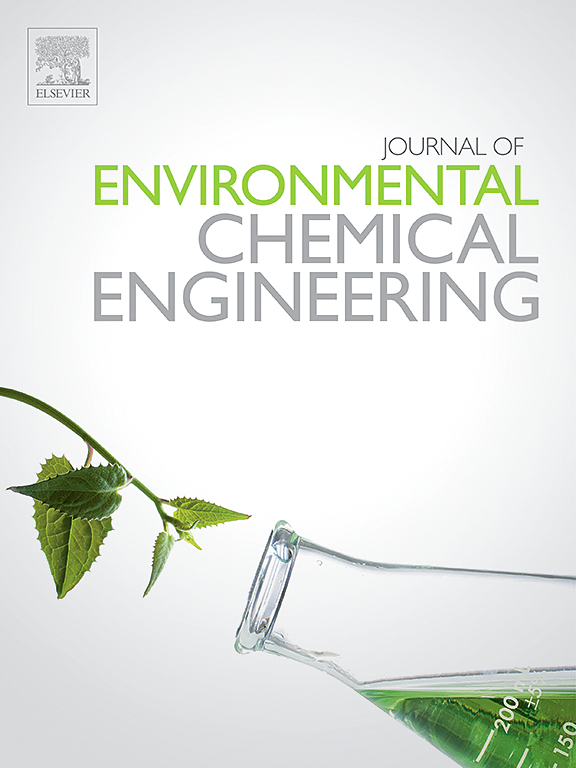化学环燃烧中的反应器设计和工艺优化:洞察燃料类型、氧载体和工艺设计
IF 7.4
2区 工程技术
Q1 ENGINEERING, CHEMICAL
引用次数: 0
摘要
化学环燃烧(CLC)是一项针对固有碳捕获与封存(CCS)而发展起来的新技术。CLC利用氧载体(OC)将氧输送到燃料中进行燃烧,从而使该过程成为氧燃料燃烧。本文旨在通过研究反应机理、温度和压力的影响以及OC对燃料反应性的影响,综述CLC在提高碳捕集效率和燃料转化方面的进展。讨论了包括流化床反应器在内的几种反应器的应用,并对其操作条件进行了讨论。各种研究报告的定量结果证明了铜基载体的高效性能,当气化温度为930℃时,效率高达93 %。固体燃料(如松木屑)使用cu基载体的燃料转换效率达到89-93.5 %,液体燃料(如甘油和丙烷)使用金属和镍基氧载体的燃料转换效率分别达到100% %。碳捕获效率各不相同,使用钛铁矿和锰基载体,pet焦炭达到97% %。CLC的能量负荷估计为0.3 GJ/tCO₂,研究表明与胺基吸收相比,CAPEX降低了6 %,OPEX降低了14 %。确定了化学环研究的未来范围和需要解决的挑战。本文章由计算机程序翻译,如有差异,请以英文原文为准。
Reactor design and process optimization in chemical looping combustion: Insights into fuel types, oxygen carriers, and process design
Chemical looping combustion (CLC) is a novel technique developed for inherent carbon capture and storage (CCS). CLC utilizes an oxygen carrier (OC) to transport oxygen to the fuel for combustion, hence making the process oxy-fuel combustion. This article aims to review the process of CLC in terms of improving carbon capture efficiency and fuel conversion by studying the reaction mechanism, effect of temperature and pressure, and the effect of reactivity of OC towards fuel. The applications of several reactors, including fluidized bed reactor, have been discussed with reference to the operating conditions employed. The quantitative findings reported in various studies proved the efficient performance of copper based carriers achieving efficiency as high as 93 % when the gasification temperature was 930°C. Fuel conversion efficiencies reach 89–93.5 % for solid fuels like pine sawdust with Cu-based carriers, and up to 100 % for liquid fuels like glycerin and propane using metallic and nickel-based oxygen carriers, respectively. Carbon capture efficiencies vary, with pet coke achieving 97 % using ilmenite and Mn-based carriers.The energy duty for CLC is estimated at 0.3 GJ/tCO₂, with studies showing a 6 % reduction in CAPEX and a 14 % drop in OPEX compared to amine-based absorption. Future scope and challenges to be addressed in the chemical looping studies are identified.
求助全文
通过发布文献求助,成功后即可免费获取论文全文。
去求助
来源期刊

Journal of Environmental Chemical Engineering
Environmental Science-Pollution
CiteScore
11.40
自引率
6.50%
发文量
2017
审稿时长
27 days
期刊介绍:
The Journal of Environmental Chemical Engineering (JECE) serves as a platform for the dissemination of original and innovative research focusing on the advancement of environmentally-friendly, sustainable technologies. JECE emphasizes the transition towards a carbon-neutral circular economy and a self-sufficient bio-based economy. Topics covered include soil, water, wastewater, and air decontamination; pollution monitoring, prevention, and control; advanced analytics, sensors, impact and risk assessment methodologies in environmental chemical engineering; resource recovery (water, nutrients, materials, energy); industrial ecology; valorization of waste streams; waste management (including e-waste); climate-water-energy-food nexus; novel materials for environmental, chemical, and energy applications; sustainability and environmental safety; water digitalization, water data science, and machine learning; process integration and intensification; recent developments in green chemistry for synthesis, catalysis, and energy; and original research on contaminants of emerging concern, persistent chemicals, and priority substances, including microplastics, nanoplastics, nanomaterials, micropollutants, antimicrobial resistance genes, and emerging pathogens (viruses, bacteria, parasites) of environmental significance.
 求助内容:
求助内容: 应助结果提醒方式:
应助结果提醒方式:


